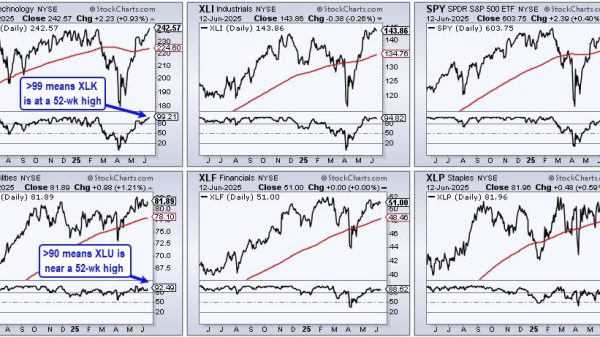Guppy Multiple Moving Average (GMMA)
The Guppy Multiple Moving Average (GMMA) is a technical analysis tool used in financial markets to analyze and interpret price trends and market sentiment. Developed by Australian trader and author Daryl Guppy, the GMMA consists of multiple sets of moving averages that provide traders with a comprehensive view of market conditions.
This tool is designed to help traders make informed decisions about buying, selling, or holding assets such as stocks, commodities, or currencies.
The GMMA consists of two main groups of moving averages: the short-term group and the long-term group. Each group serves a distinct purpose and plays a specific role in analyzing market trends. Let’s delve into these components and explore the role of GMMA in greater detail.
The Guppy Multiple Moving Average (GMMA) is comprised of groups of moving averages: a short-term group consisting of six moving averages and a long-term group also comprising six moving averages. In total, the GMMA utilizes 12 moving averages, and these are superimposed on the price chart of the asset being analyzed.
Short-term group
The short-term group in the GMMA consists of shorter-duration moving averages, typically exponential moving averages (EMAs). These shorter EMAs are calculated over relatively short periods, such as 3, 5, 8, or 10. The short-term group helps traders identify short-term trends and gauge the immediate momentum in the market.
Long-term group
The long-term group, on the other hand, consists of longer-duration EMAs. These are calculated over periods like 30, 35, 40, or 50 periods. The long-term group provides insights into the broader, more significant trends in the market and helps traders identify the overall direction of the asset’s price.
The GMMA employs these two groups of moving averages to capture both short-term fluctuations and long-term trends in asset prices simultaneously. This dual perspective offers traders a comprehensive understanding of market dynamics, allowing them to make more informed decisions.
Interpretation and role of GMMA
Now that we understand the basic components of the GMMA, let’s explore its role and how it is interpreted by traders:
One of the primary purposes of the GMMA is to identify trends in the market. When the short-term moving averages in the short-term group cross above the long-term moving averages in the long-term group, it’s often interpreted as a signal that an uptrend is developing.
Conversely, when the short-term moving averages cross below the long-term moving averages, it’s seen as a signal that a downtrend may be forming. These crossovers are referred to as “compression” or “expansion” phases and play a crucial role in trend identification.
Strength of Trend:
The spacing between the short-term and long-term moving averages within each group can provide insights into the strength of the trend. A widening gap between the short-term and long-term groups suggests a strong trend, while a narrowing gap may indicate weakening momentum or consolidation.
Market sentiment
The GMMA can also be used to gauge market sentiment. When the short-term group is above the long-term group, it suggests that short-term traders dominate the market, and sentiment may be more bullish. Conversely, when the short-term group is below the long-term group, it indicates that long-term investors have more influence, and sentiment may be bearish.
Support and Resistance Levels
The GMMA can help identify potential support and resistance levels. Areas where the short-term and long-term moving averages converge or overlap often act as significant support or resistance zones. Traders pay close attention to these levels for potential reversal points.
Trade Signals
GMMA can generate trading signals. A common strategy is to enter a long position when the short-term group crosses above the long-term group in an uptrend, indicating a potential buying opportunity. Conversely, in a downtrend, a short position may be considered when the short-term group crosses below the long-term group.
Risk Management
Traders often use the GMMA to manage risk. Stop-loss levels can be set based on the spacing between the moving averages. For example, wider spacing may allow a larger stop-loss to withstand market fluctuations, while narrower spacing may require a tighter stop-loss to limit potential losses.
Confirmation with other indicators
While the GMMA can provide valuable insights, traders often use it in conjunction with other technical indicators and tools for confirmation. Combining GMMA with oscillators, volume analysis, or trendlines can enhance the accuracy of trading decisions.
Adaptability
The GMMA is flexible and can be adjusted to suit different timeframes and asset classes. Traders can choose different periods for the short-term and long-term moving averages based on their trading preferences and the specific market they are analyzing.
Risk warning
It’s important to note that the GMMA, like any technical analysis tool, is not foolproof and cannot guarantee profitable trades. Traders should always exercise caution, employ proper risk management, and consider fundamental and macroeconomic factors alongside technical analysis.
In conclusion, the Guppy Multiple Moving Average is a versatile and comprehensive technical analysis tool that plays a significant role in helping traders identify trends, assess market sentiment, and make informed trading decisions.
By incorporating both short-term and long-term moving averages, the GMMA provides a holistic view of market dynamics, enabling traders to adapt to changing conditions and potentially increase their chances of success in the financial markets. However, it should be used in conjunction with other forms of analysis and risk management strategies to mitigate potential losses and maximize trading effectiveness.
The post Guppy Multiple Moving Average (GMMA) appeared first on FinanceBrokerage.
























